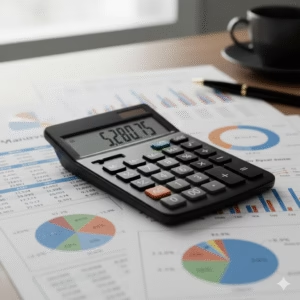5 questions every investor should ask before the new year
Take a look at these 5 questions you should ask yourself before the year ends

The end of the year brings a powerful mix of reflection and ambition. We look back at the 12 months we just lived and instinctively start planning for the “fresh start” the new year represents. We buy planners, set resolutions, and promise ourselves this will be the year we finally take control.
For investors, this ritual should be more than just a vague hope to “make more money.” It’s a critical, non-negotiable time for a strategic review.
Why? Because investing without a plan is just gambling. And a plan that is never reviewed is just a forgotten wish. Your portfolio, your goals, and the economic landscape are not static; they are in constant motion. The end of the year is the perfect time to stop, look under the hood, and make the small adjustments that will compound into massive results over time.

This isn’t about “timing the market” or finding a hot tip for 2026. It’s about controlling what you can actually control. Ask yourself these five simple but profound questions this December. Your future, wealthier self will thank you for it.
1. How Did My Portfolio Actually Perform in 2025, and (More Importantly) Why?
This is the “look-back” question. It’s the foundational step that informs all the others. But most investors get this wrong. They’ll log into their 401(k), see the final number, and say, “Cool, it went up,” or “Ouch, it went down,” and then close the window. This is useless.
You need to be a detective. Your goal is to understand the drivers behind your performance.
How to Do a Real Performance Review:
- Go Beyond the Final Number: Your portfolio went up 8%. Is that good? If the S&P 500 (a common benchmark for the U.S. stock market) went up 14%, then your 8% is actually a significant underperformance. You need to compare your results to a relevant benchmark. If your portfolio is 60% U.S. stocks and 40% bonds, you should compare it to a 60/40 benchmark, not just the S&P 500.
- Identify Your “Winners” and “Losers”: Look at your individual holdings.
- What were your best-performing assets? Was it a single stock that had a lucky run? Was it a broad index fund?
- What were your worst-performing assets?
- Ask “Why?” (The Hard Part):
- If you underperformed: Was it because of high fees? (That 1.5% “advisory fee” is a 1.5% drag on your performance every single year). Was it because you were too conservative (e.g., holding too much cash)? Was it because you tried to “pick stocks” and chose poorly?
- If you outperformed: Be honest. Was it skill, or was it luck? Did you outperform because you took on a massive, concentrated risk (like putting 50% in one hot stock) that just happened to pay off? This isn’t skill; it’s a sign of a high-risk habit that could destroy your portfolio next year.
- Did you panic-sell? The biggest “loser” in most portfolios isn’t a bad stock; it’s investor behavior. Did you sell everything when the market dipped in March, only to buy back in after it recovered in June? If so, you’ve identified the real problem: your emotional reaction to volatility.
You cannot make intelligent changes for 2026 until you have an honest diagnosis of what went right—and wrong—in 2025.
2. Is My Current Asset Allocation Still Aligned With My Goals and Risk Tolerance?

This is the single most important question for managing your long-term wealth. “Asset allocation” is simply the “recipe” for your portfolio—the mix of stocks, bonds, cash, and other assets you own.
This recipe was designed (hopefully) to match your specific goals (e.g., “retire in 20 years”) and your risk tolerance (e.g., “I can’t stomach a 30% drop”).
The problem is that your recipe doesn’t stay the same. It “drifts.”
The Danger of “Portfolio Drift”
Let’s say you started with a classic 60% stock / 40% bond “recipe.”
- You invest $10,000: $6,000 in stocks and $4,000 in bonds.
- Over the next two years, stocks have a fantastic run and grow by 40%.
- Bonds, being the stable part, grow by 5%.
- Your $6,000 in stocks is now worth $8,400.
- Your $4,000 in bonds is now worth $4,200.
- Your total portfolio is $12,600.
What’s your recipe now?
- Your stocks now make up 66.7% of your portfolio ($8,400 / $12,600).
- Your bonds are only 33.3%.
Your “moderate” 60/40 portfolio has drifted into a more aggressive 67/33 portfolio without you doing anything. You are now taking on more risk than you originally intended. When the next market crash comes, you’re going to feel it a lot more.
The Solution: Rebalancing
The end of the year is the perfect time to rebalance. This is the non-emotional, disciplined act of restoring your original recipe. In the example above, you would sell some of your “winner” stocks (selling high) and use that money to buy more of your “underperformer” bonds (buying low).
This is the physical mechanism for “Buy Low, Sell High.” It forces you to take profits and manage risk.
Sub-Question: Has Your Life Changed?
Your recipe might also need to change because you changed.
- Did you get a new, high-paying job? (You can likely take on more risk).
- Did you have a child? (You may want less risk as you start a 529 plan).
- Are you now 5 years away from retirement instead of 10? (You definitely need to reduce risk and shift more to bonds).
Don’t just rebalance to your old recipe. First, confirm that the old recipe is still the right one for the person you are today.
3. Am I Taking Full Advantage of Every Tax Break and ‘Free Money’ Opportunity?
Investing isn’t just about what you earn; it’s about what you keep. The U.S. tax code is complicated, but it’s filled with massive incentives to help you build wealth. The end of the year is your last chance to use many of them.
If you don’t answer this question, you are actively choosing to pay more in taxes and build wealth slower.
Your Year-End Tax-Advantaged Checklist:
- Are you getting your FULL 401(k) match?If your employer offers a 4% match and you only contribute 3%, you are leaving free money on the table. This isn’t an “investment” with a 6% return. This is a guaranteed 100% return on your contribution. There is no better deal in all of finance. Check your payroll deductions now and set a plan to get the full match in 2026.
- Can you max out your 401(k) for 2025?You only have until December 31 to hit the 2025 contribution limit ($23,000 if under 50; $30,500 if 50+). If you’re getting a year-end bonus, consider dumping all of it into your 401(k) to hit this limit. This will dramatically reduce your 2025 taxable income.
- Have you funded your IRA (or Roth IRA)?The good news: You have until the tax-filing deadline (April 2026) to contribute to your IRA for the 2025 tax year. But why wait? If you have the cash, get it invested now so it has more time to grow.
- Are you using a Health Savings Account (HSA)?If you have a High-Deductible Health Plan (HDHP), the HSA is the single best investment account in existence. It’s “triple-tax-advantaged”:
- Your contributions are tax-deductible (lowers your income now).
- Your money grows 100% tax-free.
- Your withdrawals are 100% tax-free (for medical expenses, now or in retirement).It’s a secret retirement account. You have until the tax deadline to contribute for 2025.
- Should you perform a Tax-Loss Harvest?This is a strategy for your taxable brokerage account (not your 401k/IRA). Look back at your “losers” from Question #1. Do you have any investments that are worth less than you paid?
- The Strategy: You can sell those “losers” and “harvest” the capital loss.
- The Benefit: That loss can be used to cancel out any capital gains you have from selling “winners.”
- The Bonus: If your losses are greater than your gains, you can use up to $3,000 of that net loss to reduce your regular income from your job.
- The Catch (Wash Sale Rule): You must wait 31 days to buy back the same or a “substantially identical” security. December is your last chance to do this for the 2025 tax year.
4. How ‘Antifragile’ Is My Financial Life If 2026 Is a Terrible Year?
“Antifragile” is a term for something that doesn’t just survive shocks—it gets stronger from them. For most of us, just being “resilient” (able to survive) is the goal.
Investing is offense. But you cannot play offense without a bulletproof defense. A single bad year—a job loss, a medical emergency, a new roof—can wipe out a decade of investment gains if you’re not prepared.
Ask yourself: If 2026 goes completely wrong, am I protected?
Your Financial Defense Checklist:
- How Is Your Emergency Fund?Be honest. Do you have 3-6 months of living expenses? Not 3-6 months of salary, but the bare-bones amount you need to keep the lights on and food on the table.
- Sub-Question: Where is it? If your $20,000 emergency fund is sitting in a checking account earning 0.01%, you are losing money to inflation every single day. At a minimum, it should be in a High-Yield Savings Account (HYSA) earning a competitive interest rate.
- Am I Carrying High-Interest ‘Bad’ Debt?If you are trying to decide whether to invest an extra $500 while carrying a $5,000 credit card balance at 22% APR, you are making a massive mistake. Paying off that credit card is a guaranteed, tax-free 22% return on your money. You will not find that anywhere else. Before you plan your 2026 investment strategy, you must have a plan to kill this debt.
- Have I Done an Insurance Check-Up?Insurance is the part of your defense that protects you from total ruin.
- Health Insurance: Is your current plan the best one for 2026, or did you just default to it?
- Auto/Home: When was the last time you shopped for rates? Loyalty is rarely rewarded.
- Life Insurance: If anyone (a spouse, a child) depends on your income, do you have a term life insurance policy?
- Disability Insurance: What’s your plan if you get sick or injured and can’t work for six months? This is your single most overlooked and most valuable asset—your ability to earn an income.
- Are My Beneficiaries Updated?This is the 5-minute task that can save your family from a legal and financial nightmare. Log into your 401(k), your IRA, and your life insurance policy. Who is listed as the beneficiary? If it’s an ex-spouse or a deceased relative, you are setting your loved ones up for a catastrophe. Fix it. Now.
5. What Is My Written Financial Plan and Automation Strategy for 2026?

You’ve reviewed the past (Q1), checked your risk (Q2), optimized your taxes (Q3), and built your defense (Q4). Now it’s time to build the plan for 2026.
If you don’t do this, all your review work was for nothing. “I want to save more” is a wish. “I will auto-transfer $500 a month to my Roth IRA” is a plan.
Create SMART Goals for 2026
Don’t use vague wishes. Use SMART goals:
- Specific: “I will max out my 2026 Roth IRA.”
- Measurable: “$6,500” (or whatever the 2026 limit is).
- Achievable: “I will do this by setting up an auto-transfer of $542 per month.”
- Relevant: “This will build my tax-free retirement nest egg.”
- Time-bound: “I will start the transfer on January 15th.”
Build Your 2026 Automation “Machine”
Willpower fails. Systems don’t. The single best way to guarantee you will meet your 2026 goals is to automate them. Make “saving” and “investing” the first “bill” you pay, not the last.
This is the “Pay Yourself First” model. Here’s how it works:
- Your Paycheck hits your checking account.
- Day 1 (Automatic): Your 401(k) contribution is already taken out (pre-tax).
- Day 2 (Automatic): A transfer goes from your checking account to your High-Yield Savings Account (to build your emergency fund or save for a big goal like a house).
- Day 2 (Automatic): A transfer goes from your checking account to your Roth IRA or taxable brokerage account (for your long-term investments).
- Day 3 (Automatic): Your mortgage, car payment, and other fixed bills are auto-paid.
What is left in your checking account is your guilt-free money for groceries, gas, and fun. You have already paid your most important “bill”—your future self.
Stop Predicting, Start Planning

No one knows what the market will do in 2026. No one. The “experts” on TV are just guessing.
Stop wasting your energy trying to predict the unpredictable. Focus 100% of your effort on what you can control: your savings rate, your asset allocation, your costs, your taxes, and your plan.
This is your new year’s resolution. Don’t just step into 2026. Step into it with a plan. Take an afternoon this December, pour a cup of coffee, and sit down with these five questions. It will be the most profitable financial move you make all year.





